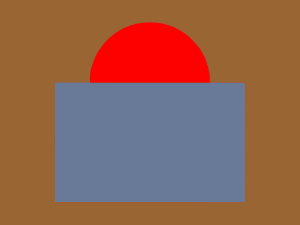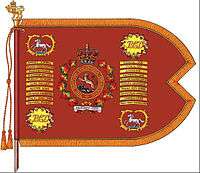The British Columbia Dragoons
| The British Columbia Dragoons | |
|---|---|
 | |
| Active | 1908–present |
| Country | Canada |
| Branch | Primary Reserve (Militia) |
| Type | Line Cavalry |
| Role | Armoured reconnaissance |
| Size | Two squadrons |
| Part of | Royal Canadian Armoured Corps |
| Garrison/HQ |
RHQ: (Kelowna) |
| Motto(s) | Chinook Jargon: Quansem ilep (always first) |
| March |
Quick: "Fare Ye Well Inniskilling (5th Royal Inniskilling Dragoon Guards)" Pipe bands: "Scotland the Brave" |
| Abbreviation | BCD |
The British Columbia Dragoons (BCD) is a Primary Reserve armoured reconnaissance regiment of the Canadian Forces. It is based in Kelowna and Vernon, British Columbia. The British Columbia Dragoons are part of 3rd Canadian Division's 39 Canadian Brigade Group.
The British Columbia Dragoons perpetuate the 2nd Battalion, Canadian Mounted Rifles and the 11th Regiment, Canadian Mounted Rifles, of the Canadian Expeditionary Force.[1]
Detachments
History
The British Columbia Dragoons trace their origins to the formation of the Canadian Mounted Rifles, two independent squadrons of horse in Kamloops and Vernon in 1908. In 1910 two additional squadrons were raised and the regiment was renamed the British Columbia Horse. In 1912 the unit was renamed again as the 30th Regiment, British Columbia Horse. 1914 saw the formation of the Victoria Independent Squadron on Vancouver Island.
- World War I graves of 2nd Canadian Mounted Rifles in Cathays Cemetery, Cardiff
 Grave of Sgt W Tremain, died 19 November 1917
Grave of Sgt W Tremain, died 19 November 1917 Grave of Pte JW White, died 24 December 1917
Grave of Pte JW White, died 24 December 1917
In the Great War the regiment was not mobilized, but in December 1914 many volunteers from the regiment joined the newly formed 2nd Regiment Canadian Mounted Rifles. After some limited service in France as cavalry, the unit was reroled to infantry as 2nd Canadian Mounted Rifles Battalion on January 1, 1916.[2] The battalion became part of the 8th Canadian Infantry Brigade, and fought with great luck and success on the Western Front. Despite being trained as cavalry but deployed as infantry, the regiment managed the war well. Captain "Jock" MacGregor was awarded the Victoria Cross for actions taken in the battle at Cambrai on September 29, 1918. The actions and awards of the 2nd Canadian Mounted Rifles are perpetuated today by the British Columbia Dragoons, their direct descendants.
In the post war reorganization, the regiment was renamed The British Columbia Mounted Rifles in 1920, and then to the name still carried today, The British Columbia Dragoons in 1929. Part of the reason for the change was to forever divorce the regiment from infantry duties. When the Second World War loomed, the regiment once again stepped forward.

The regiment was designated the 5th Motorcycle Regiment (BCD), and later an armoured car unit. Finally made into an armoured regiment, the 9th Armoured Regiment (BCD), they were deployed to Italy as part of the 2nd Armoured Brigade, 5th Canadian (Armoured) Division. The regiment saw heavy action in the Liri Valley, were the first unit to break through the Gustav Line in Italy, 1944, and helped smash the Gothic Line, holding Point 204 right in the centre of the line. Part of the "Spaghetti League", a term used by soldiers fighting in Italy after D-Day, they continued to fight until orders were given to move the regiment to the northwest Europe area. They served with distinction until the end of the war, at which point the regiment was demobilized and returned to Militia service.
The regiment has since seen many ups and downs, with losses of manpower and funding, hostile popular attitudes, and the ever changing nature of Canada. The 1970s and 1980s saw the deployment of individual members to Cyprus as part of the UN operations there as part of larger Canadian formations. The 1990s and the new century has seen numerous members deploy to Bosnia as part of NATO operations with IFOR and SFOR. With the Global War on Terror, members are now serving overseas as part of NATO operations with ISAF in Afghanistan.
Lineage of the British Columbia Dragoons:[3]
| Lineage | ||||||||||||||||||||||||||||||||||||||||||||||||||||||||||||||||||||||||||||||||||||||||||||||||||||||||||||||||||||||||||||||||||||||||||||||||||||||||||||||||||||||||||||||||||||||||||||||||||||||||||||||||||||||||||||||||||||||||||||||||||||||||||||||||||||||||||||||||||||||||||||||||||||||||||||||||||||||||||||||||||||||||||||||||||||||||||||||||||||||||||||||||||||||||||||||||||||||||||||||||||||||||||||||||||||||||||||||||||||||||||||||||||||||||||||||||||||||||||||||||||||||||||||||||||||||||||||||||||||||||||||||||||||||||||||||||||||||||||||||||||||||||||||||||||||||||||||||||||||||||||||||||||||||||||||||||||||||||||||||||||||||||||||||||||||||||||||||||||||||||||||||||||||||||||||||||||||||||||||||||||||||||
|---|---|---|---|---|---|---|---|---|---|---|---|---|---|---|---|---|---|---|---|---|---|---|---|---|---|---|---|---|---|---|---|---|---|---|---|---|---|---|---|---|---|---|---|---|---|---|---|---|---|---|---|---|---|---|---|---|---|---|---|---|---|---|---|---|---|---|---|---|---|---|---|---|---|---|---|---|---|---|---|---|---|---|---|---|---|---|---|---|---|---|---|---|---|---|---|---|---|---|---|---|---|---|---|---|---|---|---|---|---|---|---|---|---|---|---|---|---|---|---|---|---|---|---|---|---|---|---|---|---|---|---|---|---|---|---|---|---|---|---|---|---|---|---|---|---|---|---|---|---|---|---|---|---|---|---|---|---|---|---|---|---|---|---|---|---|---|---|---|---|---|---|---|---|---|---|---|---|---|---|---|---|---|---|---|---|---|---|---|---|---|---|---|---|---|---|---|---|---|---|---|---|---|---|---|---|---|---|---|---|---|---|---|---|---|---|---|---|---|---|---|---|---|---|---|---|---|---|---|---|---|---|---|---|---|---|---|---|---|---|---|---|---|---|---|---|---|---|---|---|---|---|---|---|---|---|---|---|---|---|---|---|---|---|---|---|---|---|---|---|---|---|---|---|---|---|---|---|---|---|---|---|---|---|---|---|---|---|---|---|---|---|---|---|---|---|---|---|---|---|---|---|---|---|---|---|---|---|---|---|---|---|---|---|---|---|---|---|---|---|---|---|---|---|---|---|---|---|---|---|---|---|---|---|---|---|---|---|---|---|---|---|---|---|---|---|---|---|---|---|---|---|---|---|---|---|---|---|---|---|---|---|---|---|---|---|---|---|---|---|---|---|---|---|---|---|---|---|---|---|---|---|---|---|---|---|---|---|---|---|---|---|---|---|---|---|---|---|---|---|---|---|---|---|---|---|---|---|---|---|---|---|---|---|---|---|---|---|---|---|---|---|---|---|---|---|---|---|---|---|---|---|---|---|---|---|---|---|---|---|---|---|---|---|---|---|---|---|---|---|---|---|---|---|---|---|---|---|---|---|---|---|---|---|---|---|---|---|---|---|---|---|---|---|---|---|---|---|---|---|---|---|---|---|---|---|---|---|---|---|---|---|---|---|---|---|---|---|---|---|---|---|---|---|---|---|---|---|---|---|---|---|---|---|---|---|---|---|---|---|---|---|---|---|---|---|---|---|---|---|---|---|---|---|---|---|---|---|---|---|---|---|---|---|---|---|---|---|---|---|---|---|---|---|---|---|---|---|---|---|---|---|---|---|---|---|---|---|---|---|---|---|---|---|---|---|---|---|---|---|---|---|---|---|---|---|---|---|---|---|---|---|---|---|---|---|---|---|---|---|---|---|---|---|---|---|---|---|---|---|---|---|---|---|---|---|---|---|---|---|---|---|---|---|---|---|---|---|---|---|---|---|---|---|---|---|---|---|---|---|---|---|---|---|---|---|---|---|---|---|---|---|---|---|---|---|---|---|---|---|---|---|---|---|---|---|---|---|---|---|---|---|---|---|---|---|---|---|---|---|---|---|---|---|---|---|---|---|---|---|---|---|---|---|---|---|---|---|---|---|---|---|---|---|---|---|---|---|---|---|---|---|---|---|---|---|---|---|---|---|---|---|---|---|---|---|---|---|---|
|
class="wikitable"
Battle honours The guidon of The British Columbia Dragoons. Battle honours in small capitals are for large operations and campaigns and those in lowercase are for more specific battles. Bold type indicates honours authorized to be emblazoned on the regimental guidon. The Great WarSecond World War
War in Afghanistan
Recognition The camp flag of The British Columbia Dragoons. The Freedom of the City was granted by the City of Kelowna on February 11, 1963.[4] The Freedom of the City was exercised by The British Columbia Dragoons in Vernon, British Columbia on 10 May 2008.[5] Cadet unitsThere are several Royal Canadian Army Cadets units spread across British Columbia which are affiliated to the British Columbia Dragoons. Cadets are not soldiers; they are part of an organization dedicated to developing citizenship and leadership among young men and women aged 12 to 18 years of age with a military flavour, and are not required to join the Canadian Forces.
Cadet units affiliated to the British Columbia Dragoons receive support from the regiment and also are given permission to wear traditional regimental accoutrements on their uniforms. AlliancesMedia
References
External links
Order of precedence
| |||||||||||||||||||||||||||||||||||||||||||||||||||||||||||||||||||||||||||||||||||||||||||||||||||||||||||||||||||||||||||||||||||||||||||||||||||||||||||||||||||||||||||||||||||||||||||||||||||||||||||||||||||||||||||||||||||||||||||||||||||||||||||||||||||||||||||||||||||||||||||||||||||||||||||||||||||||||||||||||||||||||||||||||||||||||||||||||||||||||||||||||||||||||||||||||||||||||||||||||||||||||||||||||||||||||||||||||||||||||||||||||||||||||||||||||||||||||||||||||||||||||||||||||||||||||||||||||||||||||||||||||||||||||||||||||||||||||||||||||||||||||||||||||||||||||||||||||||||||||||||||||||||||||||||||||||||||||||||||||||||||||||||||||||||||||||||||||||||||||||||||||||||||||||||||||||||||||||||||||||||||||